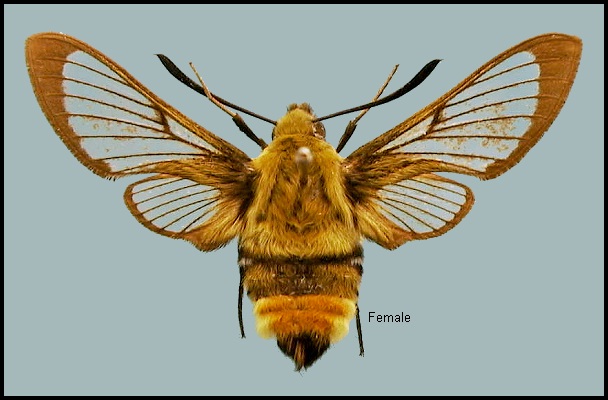
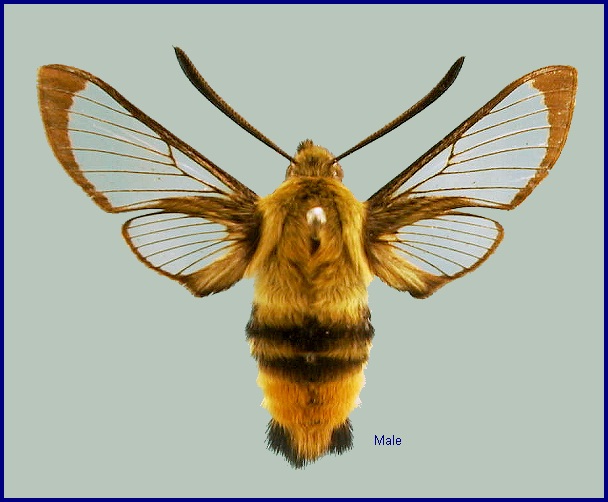
Sphinx tityus Linnaeus, 1758, Syst. Nat. (Edn 10) 1: 493. Type locality: "in calidis regionibus".
Synonym. Sphinx tityus Linnaeus, 1758.
Synonym. Sphinx bombyliformis Linnaeus, 1758, Syst. Nat. (Edn 10) 1: 493.
Synonym. Sphinx musca Retzius, 1783, Genera Insectorum: 33.
Synonym. Macroglossa knautiae Zeller, 1869, Stettin. ent. Ztg 30: 387.
Synonym. Macroglossa scabiosae Zeller, 1869, Stettin. ent. Ztg 30: 387.
Synonym. Hemaris tityus reducta Closs, 1917.
Synonym. Haemorrhagia tityus ferrugineus Stephan, 1924.
Synonym. Hemaris tityus karaugomica Wojtusiak & Niesiolowski, 1946.
Synonym. Hemaris tityus flavescens Cockayne, 1953.
Synonym. Mandarina saldaitisi Eitschberger, Danner & Surholt, 1998, Herbipoliana 4(1): 145-146.
Note. Derzhavets (1984) considered 'subsp.' alaiana Rothschild & Jordan, 1903, from the Alai range (Alayskiy Khrebat) of the western Tian Shan (Tajikistan), to be merely a form of Hemaris tityus, at best a subspecies. However, Eitschberger & Churin (2002) quite rightly treat alaiana as a distinct species. Comparison of both male and female genitalia indicate that Hemaris alaiana has evolved from an isolated population of the eastern Palaearctic Hemaris radians (Walker, 1856).
Wingspan: 40--50mm. Forewing with transparent discal cell not divided longitudinally by a scaled fold; inner edge of marginal band not expanded at M2; inner edge sometimes slightly dentate. Thorax without reddish tawny lateral strip. Antennal hook than in Hemaris fuciformis, third and fourth flagellomeres from apex broader. Hindtibia apically black. Distinguished from Hemaris fuciformis by the narrow band of scaling along the outer margin of each wing and the presence of the undivided forewing cell. Although some confusion may arise with freshly-emerged examples which have their entire wings covered with loose, grey scales, these are lost after the first flight, after which identification is made easier by a near absence of variation.
In the male genitalia, uncus and gnathos as in Hemaris fuciformis. Juxta rough with granules only apically, produced into a slender lobe. Valves asymmetrical; left valve broader than in Hemaris fuciformis, not spatulate, right valve narrowed in apical third. Left harpe represented by an obvious setose hump, evenly and broadly convex or flat; right harpe almost straight, apically clubbed and apically armed with spines. Phallus process longer than in Hemaris fuciformis, acutely pointed. In the female genitalia, antrum quite small, approximately square with rounded corners. Ductus bursae distinct, separating the antrum from the corpus bursae.
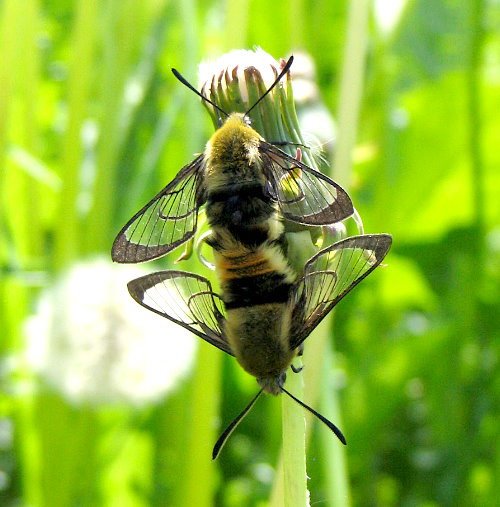
Diurnal. An insect of meadows, roadside verges and woodland glades rich in flowers, especially on chalk and sand. In such localities, vast numbers can be found in some years but very few in others, though it is never totally absent. Where this species occurs, Scabiosa (scabious) is nearly always present; however, many areas rich in this plant are devoid of Hemaris tityus. In the Tian Shan, this species is rarely found below 1000m altitude.
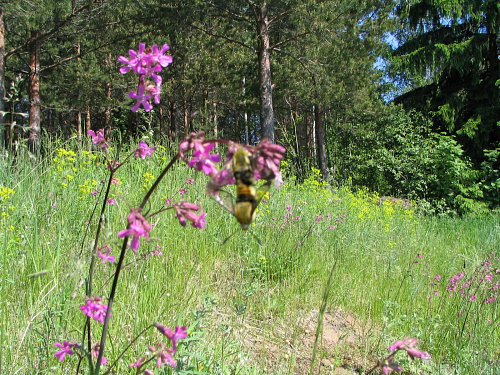
Unlike most other sphingids, this species is active during the day, generally between 10.00 and 15.00 hours, when it can be seen flitting rapidly from flower to flower of its favourite plants. Although mimicking a bumble bee in coloration, its flight is much more rapid and agile. Its skill is superbly demonstrated during courtship when pairs chase each other low over the ground as well as spiralling upwards like a whirlwind. Copulation generally follows, with pairs remaining in copula for up to two hours.
China: iv (Qinghai); v (Liaoning); vii-viii (Xinjiang). Russia: 4-26.vi (Siberia); 23.vi (Altai).
OVUM: Pale green, almost spherical (1.0 x 1.1mm), shiny and smooth, with a small depression on top. Laid singly on the underside of a leaf of the hostplant, with up to six per plant or group of plants not uncommon.
LARVA: Full-fed 50mm. The newly-hatched, white larva is about 3mm long and covered with small black tubercles bearing forked, black hairs. The caudal horn is small with two black hairs at its apex. With each moult and feeding the body and tubercles gradually become green, the horn redder, and pale dorso-lateral and ventro-lateral lines appear along the side. Fully grown, most are whitish green with a dull red horn, purple-red ventral surface and with purple-red surrounds to the spiracles. The body is very rough to the touch. Many are heavily spotted with additional reddish blotches, especially those feeding on purple-spotted scabious leaves. When fully grown, such blotches are masked as the larva turns a rich plum colour prior to pupation.
Throughout its life, the larva generally remains beneath a leaf, nibbling holes on either side of the midrib on which it rests. Most active at night; if disturbed during the day, it will drop to the ground, many even taking shelter there when not feeding. A noteworthy feature of this species is the variation in growth-rate of larvae of the same brood; however, all tend to mature much more rapidly than those of other sphingids.

PUPA: 24--27mm. Typically Hemaris in shape but blackish brown, tinted with reddish brown at the juncture of each segment. Body tapers at either end, with two sharp head tubercles and a flat triangular cremaster. Formed in a rather strong but coarse cocoon among grass tussocks, or slightly into the soil. The overwintering stage.
Larval hostplants. Usually species of Scabiosa.
Unknown for the region.
China: Xinjiang (Tian Shan, 2500-3500'; Aksu; Yining); Liaoning (Jiguanshan); Heilongjiang; Xizang/Tibet; Qinghai (Lake Qinghai).
Mongolia.
Russia: Siberia (Tomsk area; Novosibirsk; Chingisy; Alaevo; Karasuk); Altai (Novaya Ustyuba; Chemal); Tuva ASSR.
Intriguingly, a male specimen closely resembling Hemaris tityus is illustrated in Park et al. (1999) with the data 'South Korea, Kyonggi Province, Gwangleung, vi.1970, S.M. Lee'. This requires further study.
From Ireland (Lavery, 1991) across temperate Europe to the Ural Mountains (Eversmann, 1844; Kumakov, 1977), western Siberia, Novosibirsk and the Altai (Zolotarenko, Petrova & Shiryaev, 1978; Kondratiev coll., NHMUK). Also, from the Tian Shan (Alpheraky, 1882) eastwards across Mongolia to north-eastern China (Derzhavets, 1984) and also southwards to Xizang/Tibet (Chu & Wang, 1980b), including Qinghai Province (Lake Qinghai).
Also, as a separate population, across northern Turkey (de Freina, 1979) to northern Iran (Brandt, 1938; Sutton, 1963). Absent from northern Scandinavia, most of arctic Russia, and the Netherlands, where it has become extinct (Meerman, 1987).
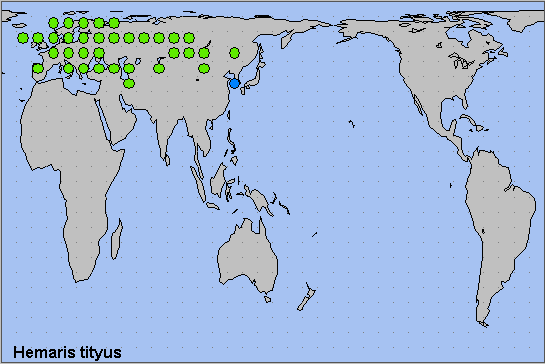
Holarctic; Palaearctic (both eastern and western). Pleistocene refuge: Polycentric -- Adriatomediterranean and Pontomediterranean subsections of the Mediterranean refuge, and the Caspian, Iranian, Turkestan, Nepali and Manchurian refugia.
 Return to Sphingidae of the Eastern Palaearctic species list
Return to Sphingidae of the Eastern Palaearctic species list